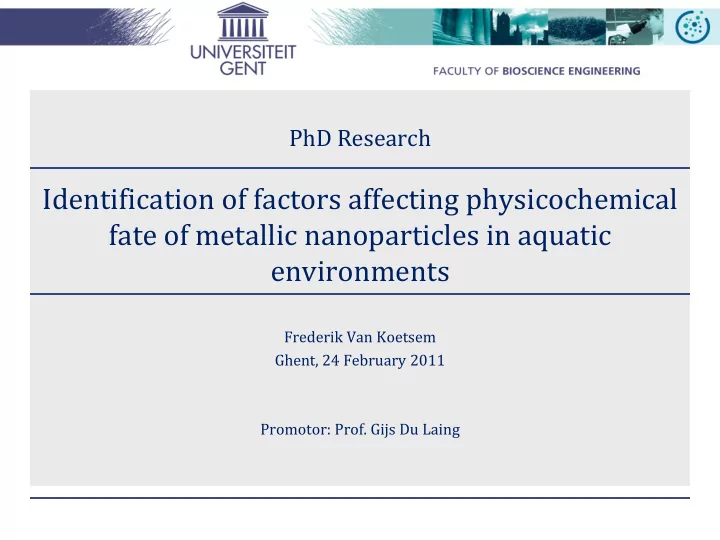

PhD Research Identification of factors affecting physicochemical fate of metallic nanoparticles in aquatic environments Frederik Van Koetsem Ghent, 24 February 2011 Promotor: Prof. Gijs Du Laing
Introduction In 1. . Met etall llic en engin ineered nan anopartic icles (E (ENPs) Ultrafine particles (1 – 100 nm) containing metals Fig. Ag Nanoparticles Fig. ZnO Nanoparticles Fig. Au Nanoparticles Can exhibit size-related properties Potential adverse effects on humans & ecosystems 2 Frederik Van Koetsem – Laboratory of Analytical Chemistry and Applied Ecochemistry – 24 February 2011
In Introduction 2. . Applic icati tions of of meta etallic ENPs 3 Frederik Van Koetsem – Laboratory of Analytical Chemistry and Applied Ecochemistry – 24 February 2011
Aim im To contribute to the identification of factors affecting the fate of metallic ENPs To reveal the kinetics of NPs’ transformation processes To study environmental factors affecting remobilization of adsorbed or precipitated metallic ENPs To aid in the development of analytical methods to quantify metallic ENPs of different sizes 4 Frederik Van Koetsem – Laboratory of Analytical Chemistry and Applied Ecochemistry – 24 February 2011
Analy lytical method development Recently, coupling of chromatographic techniques to an element specific detector as ICP-MS, e.g.: RPC-ICP-MS SEC-ICP-MS FFF-ICP-MS Focus ⇨ optimization of existing analytical procedures HDC ⇨ separation of particulate matter of ≠ sizes ICP-MS ⇨ measurement of metal content 5 Frederik Van Koetsem – Laboratory of Analytical Chemistry and Applied Ecochemistry – 24 February 2011
Analy lytical method development Current lab set-up ⇨ HPLC -ICP-MS hyphenated system Size calibration with Au NPs Method validation & additional analysis @ external labs EM techniques (e.g., TEM, SEM) DLS ζ -potential measurements BET Etc. HD HDC 6 Frederik Van Koetsem – Laboratory of Analytical Chemistry and Applied Ecochemistry – 24 February 2011
Aim im To contribute to the identification of factors affecting the fate of metallic ENPs To reveal the kinetics of NPs’ transformation processes To study environmental factors affecting remobilization of adsorbed or precipitated metallic ENPs To aid in the development of analytical methods to quantify metallic ENPs of different sizes 7 Frederik Van Koetsem – Laboratory of Analytical Chemistry and Applied Ecochemistry – 24 February 2011
Fate of f ENPs re rele leased in into aquatic environments 1. . Phy hysicochemical be behavio ior of of meta etallic ENPs Widespread use of NMs in consumer products ⇨ rel elease in in aq aquati tic, ter terrestr trial, , an and atm atmospheric en envir ironments 8 Frederik Van Koetsem – Laboratory of Analytical Chemistry and Applied Ecochemistry – 24 February 2011
Fate of f ENPs re rele leased in into aquatic environments ENPs’ unique properties ⇨ unexpected health and/or environmental hazards Few studies ⇰ Strong need for complete life cycle analysis of of the the fat fate and tra an transport t of of ENPs in in the the en envir ironment Exposure to ENPs determined by kinetics of several physicochemical transformation processes 9 Frederik Van Koetsem – Laboratory of Analytical Chemistry and Applied Ecochemistry – 24 February 2011
Fate of f ENPs re rele leased in into aquatic environments ENPs colloidal stability and mobility, NP sorption, or aggregation and deposition ⇨ f(ENP surface properties) ENP surface properties dependant on, e.g.: Temperature Ionic strength pH Particle concentration and size Redox reactions and/or association with NOM or surfactants ⇨ increasing complexity of interactions 10 Frederik Van Koetsem – Laboratory of Analytical Chemistry and Applied Ecochemistry – 24 February 2011
Fate of f ENPs re rele leased in into aquatic environments 2. . Exp xperim imenta tal pr prospect Collection of different aquatic samples, e.g.: ≠ pH, ≠ salinity, ≠ OM content, ≠ redox potential Spiking with metallic ENPs Analysis via developed analytical toolbox Additional monitoring of physicochemical characteristics Electrical conductivity, pH, redox potential, etc. Behavior ENPs ⇔ characteristics of aquatic samples ⇰ id identif ificati tion of of pa paramete ters affe affecti ting fate fate of of ENPs in in rea eal en envir ironmental sa samples 11 Frederik Van Koetsem – Laboratory of Analytical Chemistry and Applied Ecochemistry – 24 February 2011
Aim im To contribute to the identification of factors affecting the fate of metallic ENPs To reveal the kinetics of NPs’ transformation processes To study environmental factors affecting remobilization of adsorbed or precipitated metallic ENPs To aid in the development of analytical methods to quantify metallic ENPs of different sizes 12 Frederik Van Koetsem – Laboratory of Analytical Chemistry and Applied Ecochemistry – 24 February 2011
Kin inetics of f tra ransformation & re remobilization of f ENPs Environmental changes ⇨ transformation or remobilization of metallic ENP Changing environmental conditions ⇨ study the kinetics of processes affecting NP distribution Mimicking of these alterations via 16 Microcosm set-ups (developed by Prof. J Rinklebe) 13 Frederik Van Koetsem – Laboratory of Analytical Chemistry and Applied Ecochemistry – 24 February 2011
Kin inetics of f tra ransformation & re remobilization of f ENPs Microcosm set-up 14 Frederik Van Koetsem – Laboratory of Analytical Chemistry and Applied Ecochemistry – 24 February 2011
Thank you fo for your attention Any questions? 15 Frederik Van Koetsem – Laboratory of Analytical Chemistry and Applied Ecochemistry – 24 February 2011
Recommend
More recommend